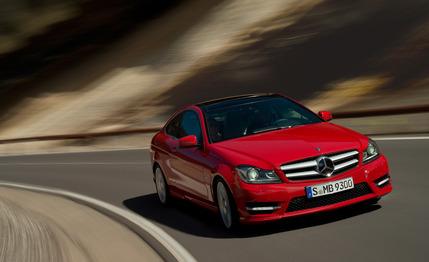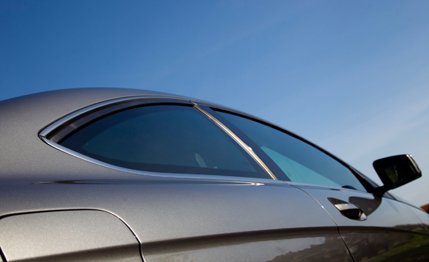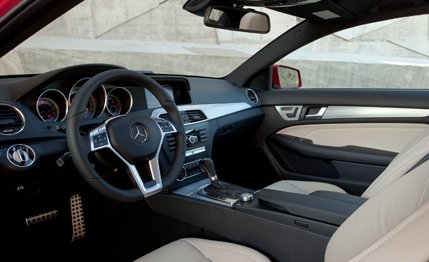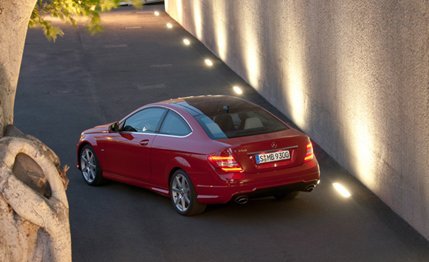 First Drive Review
First Drive Review
Worldwide, the bestselling Mercedes-Benz cars are the C-class sedan and wagon. But since the CLK ascended the Mercedes product hierarchy to become the E-class coupe, the marketing folk in Stuttgart think there’s even more sales potential in the C range. And that’s why Mercedes engineers developed the new two-door, four-seat C-class coupe.
But this new car is not just a smaller version of the E-class two-door. It is mainly a cheaper version. The C coupe costs only about $1500 more than an equivalent C-class sedan, and it shows. The design is less expressive, with simply shaped wheel arches and a rear end that looks very similar to that of the C-class sedan. It’s questionable if anyone will recognize the influence of the SL on the C coupe’s headlight design, or the presence of the BMW Hofmeister kink adjoining the car’s rear side glass. It’s more likely that Americans will instead see shadows of the Honda Accord coupe here.

To differentiate it from the C-class sedan, the new coupe’s roof is 1.5 inches lower. But it’s built on the same 108.7-inch wheelbase and to the same 180.7-inch length and 69.7-inch width. Like the sedan, it has B-pillars, and let’s be honest: A coupe with B-pillars is like Angelina Jolie with braces. (Dental braces, not leg braces. Leg braces would be hot.) And unlike the more expensive E- and CL-class coupes, the C coupe doesn’t have power rear windows or an easy-rear-entry function that pulls the front passenger seat forward. Worst of all, there is no seatbelt-delivery system, as found in your finer two-doors. Instead, the dashboard comes with exclusive design features such as a new infotainment system with silver-colored buttons. The steering wheel looks like the one in the CLS. Indeed, the interior looks great. Mercedes calls it a “lounge atmosphere,” and key C sedan safety features (Attention Assist, nine airbags) are available here.

As Mercedes does with the E-class and S-class coupe, the new C coupe offers an optional—special order, only—sport suspension package called Dynamic Handling. It lowers the body by 0.6 inch and stiffens the springs and dampers. The advantage is agile handling in sport mode, even as the system softens up midflight if it encounters crummy roads; the transition happens in as little as 10 milliseconds. The handling package also includes a stability-control-based torque-vectoring system. In fast corners at the adhesion limit, when the stability-control sensors detect encroaching understeer, the system slows the inside rear wheel in order to assist the yawing moment. As a result, the C coupe turns into corners with precise control and real determination. As in the new Mercedes SLK, the gap between sport and normal driving modes is unusually wide, resulting in two very different driving characteristics. We drove the four-cylinder C250, which follows the downsizing principle: reduced displacement compensated by direct injection and turbocharging. In keeping with Mercedes’ opaque naming conventions, the 250 packs a turbocharged 1.8-liter four-cylinder with 201 horsepower at 5500 rpm. Naturally. Compared with the V-6–powered C350, the turbo four delivers 101 fewer horsepower and 44 pound-feet less torque. But the C250 is no slouch in the torque department: The peak of 229 pound-feet happens between 2200 and 4300 rpm. So the load changes in the most frequently used rpm range seem more spontaneous, and the C250 feels more agile on winding roads than the C350, which offers its maximum 273 pound-feet between 3500 and 5250 rpm. The C250 comes with a seven-speed automatic gearbox. The 1.8-liter turbocharged engine is able to run very efficiently, achieving an observed 30 mpg. Performance is about what you’d expect—we estimate 0 to 60 in 6.7 seconds.
Thanks to various developments, including a new torsional crankshaft damper, the 1.8-liter runs comfortably at low engine speeds. As a result, the C250 turns between 1200 and 2000 rpm in city traffic, improving mileage by about seven percent, according to Mercedes.
But a coupe isn’t developed to save gas. It’s built to shorten breath. This one doesn’t.
